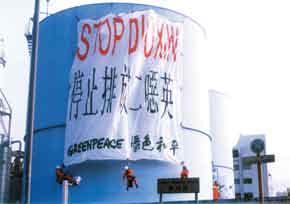Water and Sewage Treatment
Bureau is charged with protecting and managing water sources. Working together, the two agencies are responsible for guaranteeing water sources, quality, and supply for the city.121 According to a Beijing Daily Report, Beijing will benefit from some 480 million m3 of recycled water in 2007, about 14% of total water consumed in Beijing that year, and the quantity is expected to increase to 600 million m3 in 2008 through citywide initiatives.122 Beijing has instituted major water projects to divert water from Located inland on a dry plateau in China’s northeast region,
neighboring provinces in order to feed Beijing’s increasing
Beijing is a city that struggles with severe water shortages.
water demand. A water redirection project will take water
Beijing’s water availability per capita is just 1/32 of the
from Hebei Province via a 225 km canal to move over 300
international average level.118 In 2007, Beijing’s annual water
million m3 of water to Beijing. This project was scheduled
consumption reached 3.4 billion m3.119 The Olympic Games will greatly increase the city’s demand for
confirm the completion of this project.
water. An increase of 4.7 million m3 in domestic water use is
A number of new Olympic venues and refurbished venues
expected during the Games.120 According to Nanfeng Chuang
such as the National Stadium (Bird’s Nest), the Olympic
Magazine, over 300 million m3 of water from four major water
Green, and the Olympic Forest Park include water saving
reservoirs in Hebei — the Huangbizhuang reservoir and
design including rainwater collection, water efficiency, water
the Gangnan reservoir in Shijiazhuang municipality and the
re-use and water recycling features to reduce water demand
Wangkuai reservoir and the Xidayang reservoir in Baoding
during and after the Games.
municipality — will be set aside and diverted to Beijing to change the water in its artificial lakes and rivers in order for the city to have clear lakes during the Games.
In Beijing, the Games have provided an opportunity to develop the city’s sewage treatment structures. According to official sources, by May 2007, nine out of 14 planned sewage
Beijing’s water comes from two major reservoirs — the Miyun
treatment plants have been built and the five remaining ones
Reservoir and Huairou Reservoir, which are both situated to
are under construction.124
the northeast of the city. The Miyun Reservoir provides Beijing with most of its drinking water, and the Huairou Reservoir
Beijing Commitments
provides water for agriculture.
1. Beijing’s drinking water will meet WHO standards.125
The Beijing Water Authority was established in 2004 to manage
2. The drinking water source areas will be continuously
water quality and capacity. The Beijing Environmental Protection
26
for completion in April 2008.123 Greenpeace was unable to
protected.126
118. China Daily. “Project to increase Beijing’s water supply.” Updated: 2004-08-19 http://www.chinadaily.com.cn/english/doc/2004-08/19/content_366665.htm 119. Beijing Water Authority. 2007 Beijing water projects summary. http://www.bjwater.gov.cn/tabid/134/InfoID/13694/frtid/133/Default.aspx. 120. China’s Environment in 2006: Changes and Struggles. “How should Beijing cope with water shortage when hosting the 2008 Olympic Games.” Social Science Academy Press, 2006. 121. UNEP, “Beijing 2008 Olympic Games: An Environmental Review,” p.117. 122. BOCOG Media Center. “Beijing Benefits from Recycled Water.” http://en.beijing2008.cn/58/89/article214028958.shtml. 123. People’s Daily. “South-North Water Diversion emergency water diversion channel has been completed.” http://env.people.com.cn/GB/7107878.html (in Chinese). 124. BOCOG, “Beijing improves water quality.” http://en.beijing2008.cn/57/06/article214070657.shtml (in Chinese) 125. BOBICO, “4 Environmental Protection and Meteorology” p.57. 126. BOBICO, “4 Environmental Protection and Meteorology” p.57.











